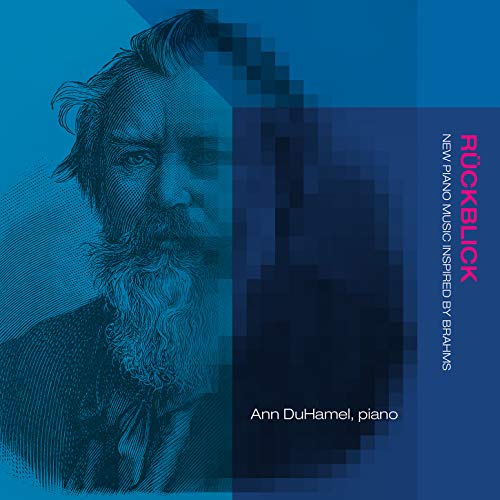RückblickNew Piano Music Inspired by BrahmsAnn DuHamel, piano
How would you re-imagine Brahms? What does transformation sound like? Pianist Ann DuHamel posed these questions to five composers—the result is her debut album Rückblick, a wide-ranging anthology of new piano music. Edie Hill’s intimate title track borrows from early and late piano works of Brahms to create a nostalgic piece that looks forward and backward in time. The miniatures of Joseph Dangerfield and Luke Dahn’s “Letters”—musical postcards from one composer to the other—pay homage to Brahms’s relationships with Joseph Joachim and Clara Schumann. Jocelyn Hagen’s lyrical variations evoke the transformations of grief. And Marc Chan’s humor and wit is on full display in his inventive re-imaginings of Brahms waltzes.
The music on this album evolved out of two considerations: a love for the music of Johannes Brahms, and the idea of transformations, musical and otherwise. I commissioned all of the pieces between 2016-2019.
Rückblick, by Edie Hill, takes its inspiration from two pieces of Brahms. The first is the Intermezzo Op. 119, No. 1, nicknamed “The Gray Pearl” by Clara Schumann; the second is the 4th movement of Brahms’s third sonata, Op. 5. This movement is also an Intermezzo; subtitled “Rückblick,” it translates to “looking back.” In the piece Hill explores the idea of looking forward and backward in time by borrowing from these two “book-end” works from Brahms’s oeuvre.
Letters is a “co-composed” set of miniatures by Joseph Dangerfield and Luke Dahn. This is an unusual model for a work; yet it draws inspiration from Brahms by hearkening back to correspondence between Brahms and his friend and colleague the violinist Joseph Joachim. In their 20s, Brahms and Joachim wrote back and forth to each other, including musical excerpts for the other to comment on. Likewise, in Letters, Dangerfield wrote the first piece, then sent it to Dahn, who wrote a piece in response, and sent that to Dangerfield. At some point the strict alternation broke down, with Dangerfield composing several in a row. For this recording, I maintain the original order of the works.
Jocelyn Hagen writes of her piece: “Variations on a Theme by Brahms is, at its heart, a piece driven by transformation, and more specifically, the stages of grief. Brahms is known for his achingly bittersweet and romantic melodies, and this theme from the third movement of his third symphony exemplifies this perfectly.”
Marc Chan’s program notes for Dr. Brahms’s Book of Rags (A Miscellany of Hemiola Hijinks and Other Syncopated Musings) states: “As Rudi Blesh writes: ‘[Ragtime] bloomed in the lurid nights of those inner cities of the [1890’s], the infamous red-light districts of brothels, saloons, casinos and wine rooms.’ Brahms’s life was indelibly marked by his traumatic experiences as a teenager playing piano in the dancehalls, bars, cafes, and whorehouses of the Hamburg waterfront. Brahms’s life tells a story of necessity and survival. So too the story of ragtime: Ragtime flourished in bawdy houses because the creators of ragtime were mostly black, with a few disowned whites, and this was the only place they could find work. Necessity, survival and transformation.” While each rag stands alone, Dr. Brahms’s Book of Rags reveals itself to be a masterfully constructed cycle. Key relationships and recurring motives contribute to its cyclical nature; subtle symmetry and mirroring occurs between the two halves. Several of the selections in Dr. Brahms’s Book of Rags evoke the music of Scott Joplin. Chan says, “it may be useful to refer to Joplin’s ‘School of Ragtime,’ and of all of his many rags, to listen to ‘Stoptime Rag,’ stoptime being a temporal innovation of Joplin’s.”
The two-movement Playing Brahms is based on two waltzes from Op. 39 – numbers 6 and 3. The first movement is very much like an etude, or like an etude spun out of control. The second movement evokes a feeling of nostalgia via a lingering, hazy resonance throughout.
*more notes in the album booklet
About the Artist
Pianist Ann DuHamel’s performances have been praised as poetic and “… a delight for the ears and the soul” (Encuentro Universitario Internacional de Saxofón, Mexico City). She’s performed in sixteen countries, including concerts at Sala Verdi in Milan, Italy; the Sibelius Academy in Helsinki, Finland; and Trinity College in Oxford, England. A champion of contemporary works, she has commissioned works by Tyler Kline and J. David Moore in addition to the composers featured on this album. In demand as a collaborative pianist, Ann has performed chamber music with members of both the Grammy Award-winning Minnesota Orchestra and the St. Paul Chamber Orchestra, as well as with Martha Councell-Vargas, flute; Preston Duncan, saxophone; and Clara Osowski, mezzo-soprano. Her performance at Carnegie Weill Recital Hall with ensemble: Périphérie was hailed by the New York Concert Review as “outstanding,” praising the group of “superb musicians” who “played with power and assurance.” Her latest project, “Prayers for a Feverish Planet,” expands and revolutionizes the modern piano recital. Featuring new works about the climate crisis, this music asks urgent questions of the listener: How do our actions generate positive change for the environment? How can we live more mindfully and conscientiously as global citizens? What sustainable impact can we create for generations to come?
Reviews
"ANN DuHAMEL/Ruckblick: Forward thinking classical pianist DuHamel wanted her debut record to really make an impact so she commissioned several composers to reimagine works by Brahms and come up with something new. There’s no reprise of his lullaby here, and there’s nothing to lull you to sleep either. Player and composers are in synch here as this set opens the ears to progressive possibilities that still lurk within.
(Furious Artisans 6821)"– Midwest Record, Chris Spector, 10/17
